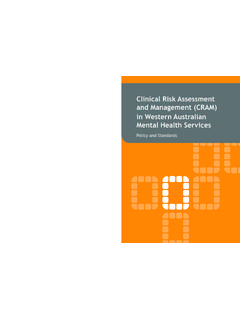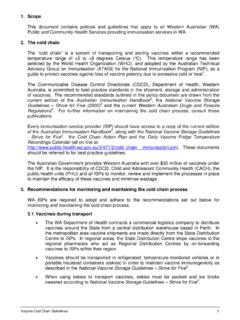Transcription of Pressure Injury Prevention and Management …
1 Pressure Injury Prevention and Management clinical Guideline Owner (initiating the document): Dr Amanda Ling, Director Office of Safety and Quality in Healthcare Contact name and number: Rachel Dennis (Ph: 9222 2197) Version: Approved by: Professor Bryant Stokes, A/Director General Date: November 2013 File number WA DoH registered file No Longer Applicable Withdrawn Nov 2017 Acknowledgements The WA Health Pressure Injury Prevention and Management clinical Guideline w as prepared for WA Health by WoundsWest on behalf of the WA Pressure Injury Forum, where it was agreed that WA Health would benefit from a state-wide clinical guideline for the Prevention and Management of Pressure injuries.
2 This clinical guideline is based on the South Australian Health Pressure Injury Prevention and Management Guideline. Suggested Citation WA Pressure Injury Forum. WA Health Pressure Injury Prevention and Management clinical Guideline. D epartment of Health 2013: Perth, Western Australia. Document Control Version Effective date Author Comment 01 Jul 2013 Initial draft developed by WoundsWest 03 Jul 2013 Review by WoundsWest 9 Jul 2013 Reviewed by Pressure Injury Forum working party 27 Aug 2013 Reviewed by WoundsWest 10 Sep 2013 Reviewed by Office of Safety and Quality in Healthcare 19 Sept 2013 Reviewed by WoundsWest 24 Oct 2013 Further editing by Office of Safety and Quality in Healthcare No Longer Applicable Withdrawn Nov 2017 Contents 1.
3 Introduction .. 1 2. Governance and quality improvement .. 2 3. clinical practice preventing and managing Pressure injuries .. 2 Screening and assessment .. 4 Prevention strategies .. 5 Managing Pressure injuries .. 6 Care planning and documentation .. 8 Discharge planning .. 8 4 clinical practice providing products, equipment, devices, pharmaceuticals to support Prevention and wound Management .. 9 5 Reporting Pressure Injury incidents .. 9 6 Communicating with patients and carers .. 10 7 Other recommended sources of information.
4 10 Appendix A The Braden Scale .. 12 Appendix B - Glamorgan Pressure Injury Screening Tool .. 13 Appendix C - WA Health Comprehensive Skin Assessment Tool .. 19 Appendix D - Pressure Injury or Skin Tear Alert Sticker .. 21 References .. 26 Acknowledgement .. 26 No Longer Applicable Withdrawn Nov 2017 1 1. Introduction Pressure injuries are largely preventable, and it is recognised that they are potentially life threatening. They also have consequences for: quality of life, infection, pain, alteration to sleep and mood, delayed healing and the provision of services.
5 The Management of the risk factors for Pressure injuries such as poor skin condition, pain, impaired mobility and poor nutritional status will have wider benefits beyond reduction of Pressure Injury , and support patient-centred holistic care and healthy ageing. The most effective approach to Pressure Injury Prevention and Management includes: Timely screening and assessment to identify risk factors; The engagement of patients and their carers with their health care providers and the treatment offered; and Implementation of a care plan that is: o Tailored to the individual and reduces their risk factors; o Supported by systems of care that are focussed on Prevention and optimising healing; o Comprehensive and inter-professional.
6 O Delivered by a skilled, knowledgeable workforce who use techniques and materials supported by current evidence to optimise healing and prevent or delay complications; and o Inclusive of access to suitable equipment and products. The WA Health Pressure Injury Prevention and Management Policy Directive and clinical Guideline describe: clinical practice that is based on the Pan Pacific clinical Practice Guideline for the Prevention and Management of Pressure Injury , 2012. Systems for the delivery of care that is in accordance with the Australian Commission on Safety and Quality in Health Care, Safety and Quality Improvement Guide Standard 8: Preventing and Managing Pressure Injuries, 2012.
7 The term patient in this document is intended to also include consumers, clients, residents and other people, however titled, receiving healthcare fr om a clinician or other healthcare pr ovider. No Longer Applicable Withdrawn Nov 2017 2 2. Governance and quality improvement All policies, protocols or procedures are based on current agreed best practice guidelines and accreditation standards, and a system for their review is in place. There are committees and work groups that have responsibility for monitoring and improving performance, and for conducting relevant quality improvement activities.
8 Pressure injuries that have developed or deteriorated during an episode of health care are reported via the clinical Incident Monitoring System (CIMS). Pressure Injury data is monitored, analysed and acted upon by ward, unit and/or service-level work groups or committees. Systems are in place to ensure that both staff expertise and resources such as equipment and products are available to enable the provision of best practice Prevention and wound Management . 3. clinical practice preventing and managing Pressure injuries clinical practice for preventing and managing Pressure injuries is summarised in the following flow chart, which outlines Pressure Injury risk assessment, preventative strategies, assessment and classification, treatment and monitoring and documentation.
9 No Longer Applicable Withdrawn Nov 2017 3 Figure 1 Reproduced from Pan Pacific clinical Practice Guideline for the Prevention and Management of Pressure Injury , 2012, with permission from Australian Wound Management Association No Longer Applicable Withdrawn Nov 2017 4 Screening and assessment On presentation, all patients will be assessed within eight hours for their risk of Pressure Injury and results documented. This assessment will include: Pressure Injury risk assessment using the Braden Scale for adults (see Appendix A) and the Glamorgan Pressure Injury Screening Tool for paediatrics and neonates (see Appendix B).
10 Skin assessment using the WA Health Comprehensive Skin Assessment Tool criteria which includes visual inspection (see Appendix C). Nutritional screening using a validated tool appropriate to the clinical setting or population. For example, the Mini Nutritional Assessment Short Form (MNASF) or the Malnutrition Screening Tool (MST). These tools usually include assessment of: o weight, height and BMI o history or unintended weight loss or gain o food intake history o dental and oral health o swallowing difficulties. Assessment of the patient s ability to feed self, and provision of assistance as required; Clinicians should use their clinical judgement in conjunction with Pressure Injury risk assessment findings to determine the patient s overall level of risk.









